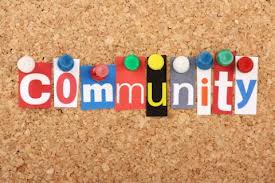 Equipping Through Community
Equipping Through Community
Can you imaging your local church going from approximately 120 to 3,120 in one weekend. That is what happened to the church at Jerusalem because of Pentecost. Churches today pray for “revival”, but if 3,000 were saved in one weekend, what would your church do with these new converts? How would they nurture them, disciple them, effectively teach them the Word particularly if they did not have a religious background, and live out what they learn? Initially everyone would gather because of the excitement of the newness of the movement, but eventually numbers would begin to dwindle. With the new income from 3,000 people coming into their coffers, today’s churches would react by hiring more staff and starting a new building program to house all the people. All looks glorious at the beginning, but as numbers dwindle, so does the financial support, and soon layoffs occur and the huge building becomes a fiscal albatross.
 In the Old Testament, priests were created to commune with God. They were a select group, one-tenth of the population, exclusively from the tribe of Levi. In the New Testament the priesthood was no longer a selective group but a collective group of anyone who had accepted Jesus as their Lord and Savior. The Old Testament elevates the priest, but nowhere in the New Testament does it talk about being a priest, only establishing a “royal priesthood”. It is the collective group that is elevated. It is the community of faith, the believers corporately in Jesus Christ, the Church. I contend that it is the Church’s job to prepare and equip these new believers corporately to do the corporate work of service. How did this community get established?
In the Old Testament, priests were created to commune with God. They were a select group, one-tenth of the population, exclusively from the tribe of Levi. In the New Testament the priesthood was no longer a selective group but a collective group of anyone who had accepted Jesus as their Lord and Savior. The Old Testament elevates the priest, but nowhere in the New Testament does it talk about being a priest, only establishing a “royal priesthood”. It is the collective group that is elevated. It is the community of faith, the believers corporately in Jesus Christ, the Church. I contend that it is the Church’s job to prepare and equip these new believers corporately to do the corporate work of service. How did this community get established?
The book of Acts vividly points out in its early chapters that this new movement of believers in Jesus Christ met in homes. They “continued to break bread together”, in other words, fellowshipped with each other. They just did not “hang out” with one another on Sundays, but daily ate meals together, fellowshipped with one another, talked with one another, shared their day, their lives, intricately becoming a part of each other. They accepted their differences, but began to blend into a group, a community, a family, a body, the Body of Christ, the Church.
They began to sacrificially give, not to build a “church” building to hold the growing numbers in their congregation, not to add new staff, for there was no staff with academic degrees to hire, not to build a Bible School or Theological Seminary to advance the academia of this new movement, but they laid their finances at the feet of Jesus, literally at the feet of the Apostles, who used it to feed the poor, take care of the needy, the widows, the homeless, and the hurting. Deacons arose “to serve tables”, or do the work of service to those in need.
By fellowshipping together, living together, participating in each other’s lives on a daily basis, “relationships” were born and established. Christianity is all about “relationships”. John 3:16 points us to our relationships with God the Father through his son, Jesus Christ, re-establishing a broken relationship caused by sin, yet sanctified through the Cross. The vertical relationship with God and man has been restored. I John 3:16 points us to our relationship with each other through the principle of “laying down one’s life” for each other. People who are willing to sacrificially do that, as Jesus had done during his life, will discover that it develops a very close community, a community that even persecution can not dissolve, a community built on intimate, committed relationships.
 Soon passions of “service” arose from this new group: some wanting to go out and evangelize, telling those who have not heard about this gospel, this “good news”; some wanting to nurture those who were already in their midst, to help them grow toward maturity in their new faith in Jesus Christ; some who discovered that all this had been foreshadowed and written about in the Torah, the Old Testament, among the prophets and the writings of David and Solomon, and diligently began to search the scriptures to reveal the truth; some to make sure this new revealed scriptural truth did not become just academic nor legalistic, but continue to be pliable, active, living. In spite of this diversity, they continued to fellowship in unity of faith and purpose. They learned to give to one another and take from one another, thus causing their relationships to deepen even further.
Soon passions of “service” arose from this new group: some wanting to go out and evangelize, telling those who have not heard about this gospel, this “good news”; some wanting to nurture those who were already in their midst, to help them grow toward maturity in their new faith in Jesus Christ; some who discovered that all this had been foreshadowed and written about in the Torah, the Old Testament, among the prophets and the writings of David and Solomon, and diligently began to search the scriptures to reveal the truth; some to make sure this new revealed scriptural truth did not become just academic nor legalistic, but continue to be pliable, active, living. In spite of this diversity, they continued to fellowship in unity of faith and purpose. They learned to give to one another and take from one another, thus causing their relationships to deepen even further.
When persecution finally did hit Jerusalem, the Church had already prepared and equipped their believers to move on in their flight for safety to all different regions throughout the world, and the Church continued to grow, develop, mature, preparing and equipping another generation to “serve” their God and “serve” one another. Soon the Church was no longer looked upon as a new Jewish sect, but a vibrant, living, organism to be reckoned with, challenging all the already existing religions and leaders of its day.
 As we have institutionalized the Church over the centuries we have lost the sense of community among believers, instead establishing divisions among us through clergy and laity and through denominational distinctions, labels and beliefs. We claim to be one body, but are so fragmented, divided, and even hostile towards one another because of our divisions. Large portions of our church budgets finance large institutions and magnificent edifices while minimal amounts go toward the poor, the widows, the homeless, and the hurting. To reestablish the power of the first century Church back into our institutions, we will have to first again establish community and the willingness to “lay down our lives” for one another, breaking bread with one another, fellowshipping daily among one another. We will have to establish community back into the Church.
As we have institutionalized the Church over the centuries we have lost the sense of community among believers, instead establishing divisions among us through clergy and laity and through denominational distinctions, labels and beliefs. We claim to be one body, but are so fragmented, divided, and even hostile towards one another because of our divisions. Large portions of our church budgets finance large institutions and magnificent edifices while minimal amounts go toward the poor, the widows, the homeless, and the hurting. To reestablish the power of the first century Church back into our institutions, we will have to first again establish community and the willingness to “lay down our lives” for one another, breaking bread with one another, fellowshipping daily among one another. We will have to establish community back into the Church.